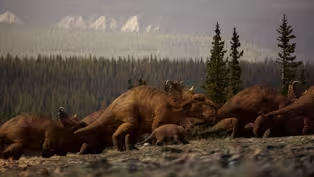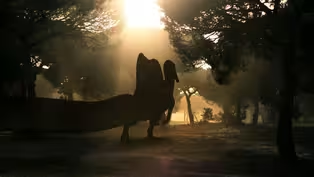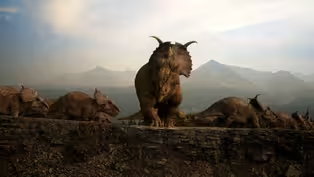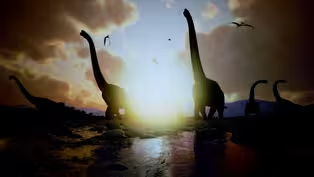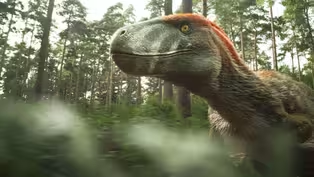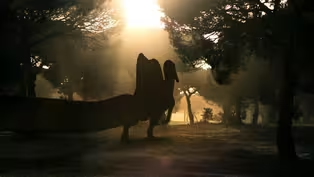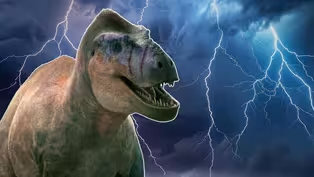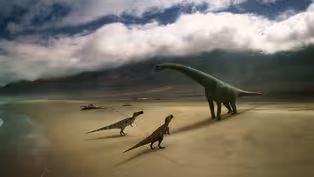
Did Dinosaurs Abandon Their Young to Help Them Survive?
Special | 5m 45sVideo has Closed Captions
In late Cretaceous Alberta, many apex predators roamed free, so how did the prey survive?
In late Cretaceous Alberta, apex predators roamed free in vast numbers, so how did the prey survive? Edmontosaurus are large, herbivorous dinosaurs, and one of the most abundantly found dinosaur species in Alberta and beyond, yet the fossils of the young and the old are rarely found together. Could abandoning their young really help them survive to adulthood?
Problems playing video? | Closed Captioning Feedback
Problems playing video? | Closed Captioning Feedback
Narrator: Bertie Carvel With Thanks: University of Alberta Laboratory for Vertebrate Paleontology, Royal Tyrrell Museum of Paleontology, Dig staff and volunteers Digital Producer & Director: Mark Atwill Digital Producer: Tom...

Did Dinosaurs Abandon Their Young to Help Them Survive?
Special | 5m 45sVideo has Closed Captions
In late Cretaceous Alberta, apex predators roamed free in vast numbers, so how did the prey survive? Edmontosaurus are large, herbivorous dinosaurs, and one of the most abundantly found dinosaur species in Alberta and beyond, yet the fossils of the young and the old are rarely found together. Could abandoning their young really help them survive to adulthood?
Problems playing video? | Closed Captioning Feedback
How to Watch Walking with Dinosaurs
Walking with Dinosaurs is available to stream on pbs.org and the free PBS App, available on iPhone, Apple TV, Android TV, Android smartphones, Amazon Fire TV, Amazon Fire Tablet, Roku, Samsung Smart TV, and Vizio.
Providing Support for PBS.org
Learn Moreabout PBS online sponsorshipMore from This Collection
Check out our 12 digital exclusives from our series Walking with Dinosaurs with BBC.
When Dinosaurs Ruled the Arctic Circle
Video has Closed Captions
Very few dinosaurs made it as far North as the Arctic Circle...except for two. (5m 52s)
We Were Wrong About Spinosaurus
Video has Closed Captions
Millions of years ago, dinosaurs ruled the Earth. But underwater it was a totally different world. (6m 36s)
Were Dinosaur Brains Designed For Combat?
Video has Closed Captions
Did Pachyrhinosaurus bones always gather in such great numbers? (5m 42s)
How We Solve Jurassic Mysteries from One Bizarre Fossil
Video has Closed Captions
Would you lick a 65-million-year old dinosaur poop? (5m 19s)
How Walking with Dinosaurs Created the Most Accurate Dinos Ever
Video has Closed Captions
Join the team behind the scenes! (6m 32s)
How to Find a Dinosaur that Hollywood Dreamed Up
Video has Closed Captions
What would make a Utahraptor so much larger than other raptor species? (5m 50s)
How the Walking with Dinosaurs Team Brought a Dinosaur Back to Life
Video has Closed Captions
The Walking With Dinosaurs team reveal how they created the Spinosaurus. (5m 50s)
How Extreme Weather Is Revealing — And Destroying — Dinosaur Fossils
Video has Closed Captions
Imagine finding a rare fossil that you’ve been desperate to find - only for it to be put at risk. (5m 59s)
How an Evolutionary Arms Race Created Bizarre Dino Designs
Video has Closed Captions
It’s grudge match time. Except that this one took place over millions of years. (5m 32s)
The Dinosaurs that Could Cross the Atlantic
Video has Closed Captions
How did dinosaur fossils get there? (5m 42s)
Did a Meteor Kill All the Dinosaurs?
Video has Closed Captions
Did the asteroid kill the T. rex and Triceratops? (5m 42s)
Providing Support for PBS.org
Learn Moreabout PBS online sponsorship[insects chirping] [thrilling music] [dinosaur bellowing] -[Narrator] 71 million years ago, in what would become modern day Alberta.
[birds chirping] Thousands of Edmontosaurus ruled over this lush landscape [Edmontosaurus bellows] of vast plains and meandering rivers.
[Albertosaurus grumbles] With deadly Albertosaurus stalking their every move.
-[Henry Sharpe] If you’re looking for a good meal, they were just giant walking piles of muscle, the McDonalds of the Cretaceous.
-[Narrator] Edmontosaurus were one of the most dominant plant eaters on the continent.
-[Henry] If you think of wildebeests in Africa right now that’s Edmontosaurus because they are everywhere here.
-[Narrator] Palaeontologist Henry Sharpe thinks they had a surprising survival tactic.
A vital key to their success.
[tapping with hammer] Did Edmontosaurus abandon their defenseless young?
-[Henry] Basically the animal, it was sitting on it’s belly, right, and then the different parts kind of fell to one side.
-[Narrator] The team has discovered the final resting place of a youngster they’ve nicknamed Gary.
-Gary is a juvenile Edmontosaurus, he would have been about four meters long and what we found mostly is the body, parts of the skull and the tail.
[tapping with hammer] -[Narrator] Gary’s bones are seemingly alone.
A long way from any adult Edmontosaurus.
And for Henry that poses a mystery.
Experts believe Edmontosaurus grouped together in herds.
Allowing them to close ranks and protect each other from marauding predators.
[Edmontosaurus bellows] -[Henry] And so living in groups means that you could have one or two animals kind of looking out while the rest feed.
It’s like a meerkat strategy.
-[Narrator] But despite being social animals, the team hasn’t found adults and youngsters buried together.
[crunching] -[Henry] It’s just adult Edmontosaurus in one spot and baby Edmontosaurus in another spot.
[birds and insects chirping] -[Narrator] Edmontosaurus young were about the size of a small dog and almost defenseless.
[Edmontosaurus young whimpers] -[Henry] Juveniles are just kind of running around beneath your feet, they’re hard to take of if you’re the size of two elephants.
[Edmontosaurus bellows] -[Narrator] And that’s not all, Henry thinks young Edmontosaurus hadn’t yet developed a defense feature found in adults.
-[Henry] The juveniles, the eye sockets face very much to the side erm, but in adults this bone right behind the eye actually inflates, there’s a big sinus in it and that pushes the eye sockets to rotate to face forward a little bit more.
-[Narrator] Adult Edmontosaurus eyes pointed forwards.
This means they could spot an approaching Albertosaurus pack, [suspenseful music] track its approach and act fast.
[snort] -[Henry] If you want to avoid a fast predator like Albertosaurus, maybe what you need to do is spot it from a long way away coz then you can get a head start, you need to get your herd together and move out.
[Albertosaurus snarls] -[Narrator] But with eyes on the sides of their heads, younger Edmontosaurus wouldn’t spot danger quickly.
[nasal huffing] Small, defenseless and unlikely to spot predators, this doesn’t seem like a recipe for success.
But Henry thinks Edmontosaurus had a clever solution to ensure the next generation survived.
Whilst the very youngest may have stayed with the herd, at a certain age the juveniles go it alone.
-[Henry] Yeah, Edmontosaurus are growing up kind of alone and probably sticking to the forests and away from the big open river plains where the Albertosaurus are waiting to, to eat them.
[panic nasal call] -[Narrator] Henry thinks this strange finding could be the secret to the species success.
-[Henry] For some reason, them abandoning their young is the way to go, it’s the one that’s helping most Edmontosaurus reach maturity.
It’s a weird strategy but it’s what they did and it’s what has worked.
-[Narrator] If Henry’s right, this strategy helped Edmontosaurus become one of the most abundant dinosaurs in North America.
In just a few years, juveniles like Gary will be the size of an elephant and armed with life-saving binocular vision.
Finally ready to rejoin the herd.
[music fades]

- Science and Nature

Explore scientific discoveries on television's most acclaimed science documentary series.

- Science and Nature

Capturing the splendor of the natural world, from the African plains to the Antarctic ice.












Support for PBS provided by:
Narrator: Bertie Carvel With Thanks: University of Alberta Laboratory for Vertebrate Paleontology, Royal Tyrrell Museum of Paleontology, Dig staff and volunteers Digital Producer & Director: Mark Atwill Digital Producer: Tom...
